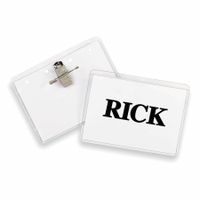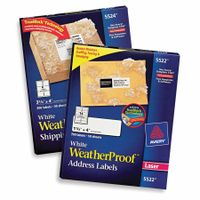Call +(254) 703 030 000 / 751 483 999 / 721 704 777
- Home
- Office Supplies
- Office Paper Notebooks
- Labels Name Badges
.....Read More
Frequently Asked Questions
What are the different types of name badge backings?
Name badge backings come in various types, each suited for different applications and preferences:
1. **Pin Backing**: A traditional option, pin backings use a sharp pin to attach the badge to clothing. They are secure but can leave small holes in fabric.
2. **Magnetic Backing**: This type uses magnets to hold the badge in place, offering a secure attachment without damaging clothing. It's ideal for delicate fabrics.
3. **Clip Backing**: Featuring a clip mechanism, this backing is easy to attach and remove. It's suitable for thicker fabrics and is often used in temporary settings.
4. **Adhesive Backing**: These are stickers that adhere directly to clothing. They are convenient for one-time use events but may not be suitable for all fabric types.
5. **Lanyard Slot**: Some badges come with a slot for attaching to a lanyard, allowing them to hang around the neck. This is common in conferences and events.
6. **Swivel Clip**: Similar to clip backings but with a swivel feature, allowing the badge to rotate. This is useful for maintaining visibility if the badge flips.
7. **Bulldog Clip**: A strong clip that grips fabric securely. It's easy to attach and remove, making it popular for reusable badges.
8. **Strap Clip**: Combines a plastic strap with a metal clip, often used for ID badges. It's durable and provides a secure hold.
9. **Hook and Loop (Velcro)**: Offers a reusable and adjustable option, suitable for uniforms or situations where badges are frequently changed.
10. **Pocket Slide**: Designed to slide over a pocket edge, providing a secure hold without any attachment to the fabric itself.
Each type of backing has its own advantages and is chosen based on the specific needs of the wearer and the environment in which the badge will be used.
How do I choose the right label for my business needs?
To choose the right label for your business needs, start by identifying the purpose of the label. Determine whether it is for branding, compliance, or informational purposes. Next, consider the material and durability requirements based on the product's environment, such as exposure to moisture, heat, or chemicals. Choose materials like paper, vinyl, or polyester accordingly.
Evaluate the design elements, including size, shape, and color, to ensure they align with your brand identity and product packaging. Ensure the label is legible and visually appealing, with clear fonts and high-quality images. Consider the printing method, such as digital, flexographic, or thermal transfer, based on your budget, volume, and quality needs.
Compliance with industry regulations is crucial, so ensure the label includes necessary information like ingredients, safety warnings, or barcodes. Research any specific labeling requirements for your industry to avoid legal issues.
Assess the quantity and frequency of label production. For small batches, digital printing may be cost-effective, while larger volumes might benefit from offset or flexographic printing. Consider the ease of application, whether manual or automated, to streamline your production process.
Finally, factor in cost-effectiveness by comparing quotes from different suppliers, considering both short-term and long-term needs. Opt for a supplier with a reputation for quality and reliability, and consider their ability to provide custom solutions if needed.
By carefully evaluating these aspects, you can select a label that meets your business needs effectively.
What materials are name badges typically made from?
Name badges are typically made from a variety of materials, each chosen for its specific properties and suitability for different environments and uses. Common materials include:
1. **Plastic**: Often used for its durability and versatility, plastic name badges can be made from acrylic, PVC, or polycarbonate. These materials are lightweight, resistant to wear and tear, and can be easily printed on or engraved.
2. **Metal**: Aluminum and stainless steel are popular choices for a more professional or upscale appearance. Metal badges are durable, resistant to corrosion, and can be engraved or printed with high-quality finishes.
3. **Paper/Cardstock**: Used for temporary or disposable badges, paper or cardstock is cost-effective and can be easily printed with detailed information. These are often used in conferences or events where badges are needed for a short duration.
4. **Wood**: For a unique and eco-friendly option, wood badges are crafted from materials like bamboo or other sustainable woods. They offer a natural aesthetic and can be laser-engraved for personalization.
5. **Fabric**: Often used for lanyard-style badges, fabric materials like polyester or nylon are durable and comfortable to wear. They can be printed with logos or text and are suitable for events or organizations where badges are worn frequently.
6. **Magnetic**: Some badges incorporate magnetic materials to attach securely to clothing without causing damage. These can be combined with other materials like plastic or metal for the badge face.
Each material offers distinct advantages, such as cost-effectiveness, durability, or aesthetic appeal, making them suitable for different applications ranging from corporate settings to casual events.
How can I ensure my labels stay securely attached?
To ensure your labels stay securely attached, follow these steps:
1. **Surface Preparation**: Clean the surface where the label will be applied. Use a mild detergent or alcohol-based cleaner to remove dust, grease, or any contaminants. Ensure the surface is dry before application.
2. **Choose the Right Adhesive**: Select a label with an adhesive suitable for the surface material and environmental conditions. Permanent adhesives are ideal for long-term use, while removable adhesives are better for temporary applications.
3. **Label Material**: Use durable label materials that match the application environment. For example, vinyl or polyester labels are suitable for outdoor use due to their resistance to moisture and UV rays.
4. **Application Temperature**: Apply labels at the recommended temperature range. Extreme temperatures can affect adhesive performance. Most adhesives work best at room temperature.
5. **Pressure Application**: Apply firm, even pressure across the entire label to ensure good contact with the surface. This helps activate the adhesive and improves bonding.
6. **Edge Sealing**: For added security, especially in harsh environments, consider edge sealing with a clear laminate or using a label with a built-in protective coating.
7. **Avoid Stretching**: Do not stretch the label during application, as this can cause it to lift over time.
8. **Environmental Considerations**: Consider environmental factors such as humidity, exposure to chemicals, or abrasion. Choose labels designed to withstand these conditions.
9. **Testing**: Conduct a small-scale test to ensure the label adheres well to the surface and remains intact over time.
10. **Regular Inspection**: Periodically check labels for signs of peeling or wear, especially in high-traffic or harsh environments, and replace them as needed.
By following these guidelines, you can enhance the longevity and security of your labels.
What are the benefits of using magnetic name badges?
Magnetic name badges offer several benefits that make them a preferred choice in various settings. Firstly, they are easy to attach and remove, eliminating the need for pins or clips that can damage clothing. This feature is particularly advantageous for employees who wear delicate fabrics or uniforms, as it preserves the integrity of their attire.
Secondly, magnetic badges provide a professional appearance. They are sleek and modern, enhancing the overall look of the wearer. This is important in environments where first impressions matter, such as in customer service or corporate settings.
Thirdly, they are highly durable. The magnets used are strong and long-lasting, ensuring that the badge stays securely in place throughout the day. This durability means that the badges can be reused multiple times, making them a cost-effective option for businesses.
Additionally, magnetic name badges are customizable. They can be designed to include company logos, employee names, and job titles, which helps in promoting brand identity and facilitating communication. This customization can be done in various styles and colors, allowing businesses to align the badges with their branding.
Moreover, these badges are comfortable to wear. Without sharp pins or bulky clips, they sit flat against the clothing, reducing discomfort for the wearer. This comfort can lead to increased employee satisfaction and willingness to wear the badges consistently.
Finally, magnetic name badges are versatile. They can be used in a wide range of industries, from hospitality to healthcare, and are suitable for both temporary and permanent staff. This versatility makes them a practical choice for organizations of all sizes.
In summary, magnetic name badges offer ease of use, professional appearance, durability, customization, comfort, and versatility, making them an excellent choice for businesses looking to enhance their identification systems.
How do I print custom labels for my business?
1. **Determine Label Requirements**: Identify the size, shape, material, and adhesive type needed for your labels. Consider the environment they will be used in and any specific durability requirements.
2. **Design Your Label**: Use graphic design software like Adobe Illustrator, Canva, or online label design tools provided by printing services. Ensure your design includes your logo, business name, and any necessary information like product details or barcodes.
3. **Choose Printing Method**:
- **In-House Printing**: Purchase a label printer suitable for your needs. Options include inkjet, laser, or thermal printers. Ensure you have compatible label sheets or rolls.
- **Professional Printing Services**: Use online services like Vistaprint, Avery, or local print shops. Upload your design and select your label specifications.
4. **Select Label Material**: Choose from paper, vinyl, polyester, or other materials based on durability needs. Consider finishes like matte, gloss, or clear.
5. **Test Print**: If printing in-house, do a test print to check alignment, color accuracy, and overall appearance. Adjust settings as needed.
6. **Order or Print Labels**:
- For in-house, print the required quantity, ensuring consistent quality.
- For professional services, place your order and review proofs if provided.
7. **Quality Check**: Inspect the printed labels for any errors or defects. Ensure they meet your quality standards.
8. **Application**: Apply labels to your products using a label applicator for consistency or manually if the quantity is small.
9. **Storage**: Store unused labels in a cool, dry place to maintain adhesive quality and prevent damage.
What are the best practices for designing effective name badges and labels?
1. **Clarity and Readability**: Use large, legible fonts for names and essential information. Sans-serif fonts like Arial or Helvetica are often preferred for their clarity.
2. **Hierarchy of Information**: Prioritize information by importance. The name should be the most prominent, followed by the title or role, and then the organization or company.
3. **Color Contrast**: Ensure high contrast between text and background for easy readability. Avoid overly bright or clashing colors that can strain the eyes.
4. **Size and Shape**: Choose a size that is large enough to accommodate all necessary information without overcrowding. Standard sizes are often 3x4 inches for badges.
5. **Material Choice**: Use durable materials like plastic or laminated paper to withstand wear and tear, especially for multi-day events.
6. **Branding**: Incorporate logos and brand colors subtly to maintain professionalism without overwhelming the primary information.
7. **Personalization**: Allow space for personalization, such as preferred pronouns or nicknames, to enhance networking and comfort.
8. **Accessibility**: Consider accessibility needs, such as braille for visually impaired attendees or magnetic clips for those who cannot use pins.
9. **Orientation**: Design badges to be worn at chest level and ensure they are double-sided to remain visible if flipped.
10. **Technology Integration**: For events, consider integrating QR codes or NFC chips for easy information sharing or access control.
11. **Simplicity**: Avoid clutter by limiting the amount of text and decorative elements. Stick to essential information only.
12. **Testing**: Prototype and test the design in real-world conditions to ensure readability and comfort.
13. **Feedback**: Gather feedback from users to improve future designs, focusing on comfort, readability, and overall effectiveness.






